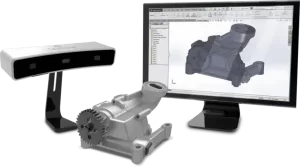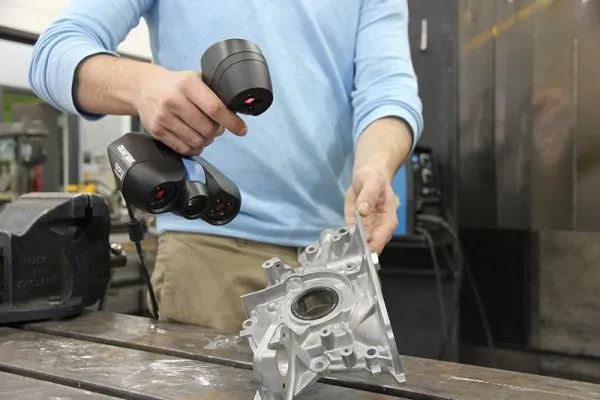3d scanning technology is transforming multiple industries with its superior accuracy and data capturing ability. From automotive to manufacturing and consumer products — this $924 million modern technology is overgrowing. Compared to the traditional processes, engineers can scan an item several times from different angles and turn a tangible product into a virtual design in seconds.
There are so many prime qualities that make 3d scanning a future-focused technology. From accuracy, speed to higher flexibility, and non-contact nature — it eases the scan process significantly. As the demand for more accurate and intricate designs increases, more companies are adopting this advancement. Before we dive into the top reasons behind using it, let’s briefly understand 3d scanning.
Table of Contents
What is 3D Scanning?
3D scanning technology is a non-destructive and non-contact method that captures the dimensions of a physical object using powerful laser light. The scanners form a large set of scanned data known as point clouds from the object’s surface. This technology can precisely capture an object’s size and shape, and later, engineers can turn it into 3D models.
Using 3d scanning, designers can measure intricate details and scan free-form shapes to form accurate point clouds in a shorter turnaround time. This technology is ideal for inspecting and measuring complex geometries and contoured surfaces. Objects with a high level of complex geometry become easy to scan as it’s a non-contact method. Once the scanners capture the complete data, the 3d model is available to view with a 360° perspective.
Top Reasons to Use 3D Scanning Technology
With a modern 3D scanning solution, engineers can speed up their design process and work on various feedback to improve it quickly. Below are some transforming reasons to use 3d scanning technology:
It Saves Substantial Time
Product designing is a time-consuming and complex process. Engineers might even take weeks to scan and process a design using the traditional method. For making the process quick and accurate, 3d scanning plays a pivotal role. Using a structured light 3d scanner, designers can quickly reverse-engineer a design and speed up the improvisation process. Compared to the convention method, 3d scanners can save substantial time while performing calculations.
3d scanners come in handy in saving time when engineers need to make alterations to an existing design. For example, whether designers need to alter the thickness of an automotive spare part or a mechanical ring, they can do it quickly. Hand-made drawings are prone to human calculations, and even making a single change might require days. However, 3d scanning automates time-consuming calculations and lets engineers prepare a 3d model faster.
Faster Prototyping
With conventional methods, engineers might need multiple attempts to create an accurate prototype. Using a 3d scanner, engineers can expedite this process in an error-free way and prepare prototypes faster. In addition, in industrial product design, 3d scanning can reduce the prototyping cycles necessary during the comprehensive design process.
Compared to the traditional process, a 3d scanner can accurately measure all cross-sections and recognizes the areas where the object is wrapped. As this process saves all the design data in real-time, it helps with faster prototyping. Engineers can produce multiple prototypes with slight changes and perform the design comparison with more precision. Once designers get the 3d model, they can quickly test the prototype against several realistic scenarios to check durability. Also, engineers can use 3d printers to convert a 3d scanned CAD design into a physical object.

Whether automotive, manufacturing, or architecture, engineers need the facility to produce a quick prototype for testing & demonstration purposes. 3D scanning simplifies this process and also makes the design communication seamless among multiple teams.
Superior Quality Control
With growing customers’ expectations for higher quality products, the need for 3d scanning is increased. Several industries are using this technology to improve their quality control to ensure superior final product manufacturing. 3d scanners can check the object’s material composition and the overall volume with higher accuracy. This data comes in handy for engineers as they can now personalize the quality control based on the available information.
Using 3d scanners, engineers can check a product’s stability, design scalability, and durability within millimeters of accuracy. Designers can check the complete object’s shape with the actual CAD file and inspect the differences quickly. 3D scanning helps designers to see the differences between the CAD file and the real thing using color maps. This process lets manufacturers save substantial time and money while initiating mass production.
Remanufacturing without CAD
In many scenarios, engineers have to remanufacture a damaged object without a CAD file. This task becomes difficult with the traditional approach as it’s challenging to capture the exact details. When it comes to restoring historical art pieces, 3d scanning plays a winning role.
Using a 3d scanner, engineers can capture the data of the physical object and convert it into a 3d model. Once the model is ready, they can process the available point clouds to form the missing elements. Several famous museums are leveraging 3d scanning technology to preserve ancient artifacts and create replicas for public demonstration.
Designers can perform a quick reverse engineer on the available object’s data and recreate the complete design without dimensional error. 3d scanning is also an ideal technology where individuals need to create a new thing on the go taking references of the damaged part. Military, aerospace and healthcare are demanding domains where 3d scanning is used to deliver faster output.
Easy Design Comparison
In industries like health care and aerospace, where the error tolerance is none — 3d scanning helps in streamlining the complex processes. In healthcare, engineers can compare whether a prosthetic is accurate or not, comparing the actual product with its CAD file. In addition to this, a single error in the smallest aerospace part can cause damage worth thousands of dollars. So, to ensure each piece fits and works in the required manner, 3d scanning gets it covered.
Even small product manufacturers can opt for a professional 3d scanning service provider to ensure their products are accurate to improve their usability. 3d scanning helps improve the existing product, and lets manufacturers know about its design scalability. It’s an ideal process for those products that need to undergo multiple changes.With the growing popularity of this technology’s robust applications, several companies now offer on-demand 3d scanning in Melbourne and other places.
CFD and FEA services
Computational Fluid Dynamics or CFD is the wind tunnel testing process used for flights to ensure the aerodynamics are intact. 3D scanning helps engineers capture the exact details of wind flow and make improvisations. On the other side, Finite Element Analysis or FEA is used to check how a component will react under multiple conditions. 3d scanning eases this process by creating accurate 3d models with 3d printing. Using CFD and FEA services, companies save millions of dollars by avoiding mistakes during mass manufacturing.
Final thoughts
Whether a business is small or operating at a large scale, 3d scan services can help in streamlining several complex design tasks. As we move towards Industry 4.0, where the changes are dynamic, 3d scanning will enable companies to stay relevant in their industry. In the future, we will see more companies leveraging 3d scanning to improve their overall product lineup.






